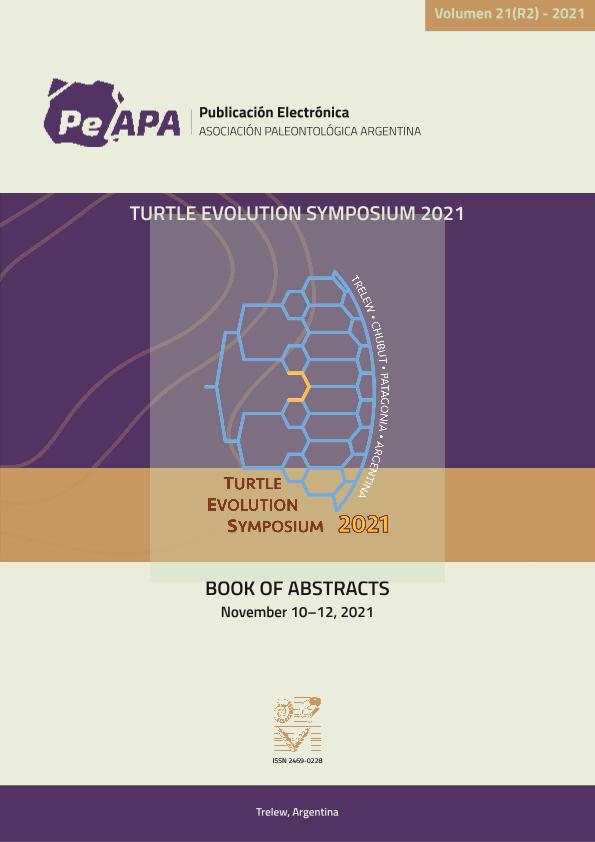Evento
Paleogene pelomedusoid turtles from northwestern Argentina: a preliminary approach
Tipo del evento:
Simposio
Nombre del evento:
Simposio de Evolución de Tortugas
Fecha del evento:
10/11/2021
Institución Organizadora:
Museo Paleontológico Egidio Feruglio;
Título del Libro:
Publicación Electrónica de la Asociación Paleontológica Argentina
Título de la revista:
Publicación Electrónica de la Asociación Paleontológica Argentina
Editorial:
Asociación Paleontológica Argentina
ISSN:
2469-0228
Idioma:
Inglés
Clasificación temática:
Resumen
The record of the Paleogene fossil pelomedusoid turtles in northwestern Argentina is scarce, with only one named species (Podocnemis argentinensis). These pelomedusoids have been discovered in several Paleocene, Eocene and Oligocene formations and localities of La Rioja (Puesto La Flecha Formation), Jujuy (Maíz Gordo, Lumbrera Formations), Tucumán (Río Loro Formation) and Salta (Gesteand Lumbrera Formations) provinces. Among the Paleogene specimens the plastron-based Podocnemis argentinensis from Maíz Gordo Formation at Quebrada Queñoal (Jujuy Province) was reconstructed by Cattoi and Freiberg in 1958 on the basis of a partial preserved plastron (holotype MACN 17988) and a referred specimen represented by a partial right epiplastron (MACN 16553) showing a simple gular-extragular scale pattern and a relatively narrow anterior plastral lobe. Two different pelomedusoid turtles in Casa Grande Area (Jujuy Province) were recovered. One of them found in outcrops of Maíz Gordo Formation at Quebrada del Puesto is assigned to an unnamed taxon of pelomedusoid characterized by a large sized, pit-decorated carapace. The other discovery is represented by several shell specimens (AMNH 3005, 9690, 9694, 9696, 9698, 25571, 25573,25575) from outcrops of the Maíz Gordo Formation exposed at Quebrada del Agujero (Jujuy Province)showing a plastral morphology similar to that of "Podocnemis" argentinensis, although they are smaller than the holotype. Among them, one skull associated with these small shells is preserved.This specimen (AMNH 9700) is characterized by a short beak, lateral orbits, interorbital groove absent, high maxilla, large vomer, pterygoid flange extended posterolaterally covering most of the pterygoid fossa, and a posterior roof elevation of the skull. These skull morphologies suggest that "Podocnemis" argentinensis from the Maíz Gordo Formation, is a podocnemidid species belonging to a different genus from Podocnemis. A skull and two shells (IBIGEO-P 107-108) represent a differenttaxon of Podocnemididae recently discovered from the Geste Formation (Eocene) in the proximity of San Antonio de Los Cobres (Salta Province). This new genus and species presents a different plastraland cranial morphology than ?Podocnemis? argentinensis. Among these characters we can list: a short and sub quadrangular anterior plastral lobe two times wider than long, angular-extragular scheme showing a punctual contact between the gular scute and humero-pectoral sulcus preventing midline contact of humeral scutes, a huge foramen palatinum posterius, and a short pterygoid flange that cover partially the cavum pterygoidei. These discoveries suggest a greater diversity than expected in the Paleogene pelomedusoid assemblage of northwestern Argentina.
Palabras clave:
TESTUDINES
,
PELOMEDUSOIDES
,
PALEOGENE
,
NOA
Archivos asociados
Licencia
Identificadores
Colecciones
Eventos (IDEVEA)
Eventos de INSTITUTO DE EVOLUCION, ECOLOGIA HISTORICA Y AMBIENTE
Eventos de INSTITUTO DE EVOLUCION, ECOLOGIA HISTORICA Y AMBIENTE
Citación
Paleogene pelomedusoid turtles from northwestern Argentina: a preliminary approach; Simposio de Evolución de Tortugas; Trelew; Argentina; 2021; 75-75
Compartir
Altmétricas




